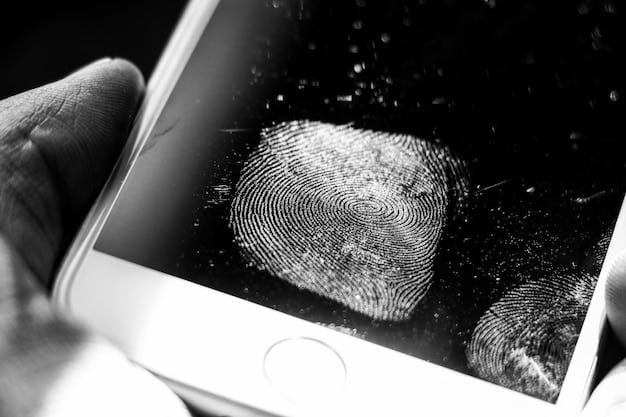Biometric Authentication: Is Gen Z Embracing a Passwordless Future?

The Rise of Biometric Authentication: Is Gen Z Ready for a Passwordless Future? explores the evolving landscape of digital security, where traditional passwords may soon be replaced by biometric methods like fingerprint scanning and facial recognition, especially among the tech-savvy Gen Z demographic.
The digital age is constantly evolving, and with it, so are the methods we use to secure our online identities. One of the most significant shifts is the move towards biometric authentication, a trend particularly relevant for The Rise of Biometric Authentication: Is Gen Z Ready for a Passwordless Future?. But is Generation Z, the digital natives, truly prepared to ditch passwords altogether?
Biometric Authentication Explained
Biometric authentication is quickly becoming a staple in modern security, promising a future where memorizing complex passwords is a thing of the past. But what exactly falls under the umbrella of “biometrics,” and why is this method gaining so much traction?
At its core, biometric authentication relies on unique biological traits to verify identity. These traits can be physical, like a fingerprint, or behavioral, such as the way someone types on a keyboard. By analyzing these distinct characteristics, systems can confirm that a user is who they claim to be.
Types of Biometric Authentication
There are several different types of biometric authentication, each with its own strengths and weaknesses. Understanding these variations is key to appreciating the breadth of biometric technology.
- Fingerprint Scanning: One of the most widely used forms, fingerprint scanning involves mapping the unique ridges and valleys on a person’s fingertip.
- Facial Recognition: This technology uses algorithms to analyze the distinct features of a person’s face, creating a digital template for verification.
- Iris Scanning: Iris scanning focuses on the intricate patterns within the iris, the colored part of the eye, to establish identity.
- Voice Recognition: Voice recognition analyzes the unique characteristics of a person’s voice, such as pitch, tone, and pronunciation, to verify their identity.
These methods offer varying levels of security and convenience, making them suitable for different applications and environments.
The rise of biometric authentication signifies a move towards more secure and user-friendly authentication methods. As technology continues to advance, these methods are likely to become even more prevalent, potentially reshaping how we interact with digital devices and services.
Gen Z: Digital Natives and Early Adopters
Generation Z, born between the late 1990s and early 2010s, has grown up immersed in technology. With this upbringing, they’ve become early adopters of new tech trends, making them crucial to the widespread acceptance of biometric authentication.
Having spent their lives surrounded by smartphones, tablets, and other digital devices, Gen Z is inherently comfortable with technology. This comfort level extends to new and emerging methods of security, including biometrics.
Gen Z’s Tech Habits and Preferences
Understanding Gen Z’s tech habits is crucial to understanding their perspective on biometric authentication. These habits shape their expectations and preferences when it comes to online security.
- Mobile-First Mindset: Gen Z is primarily mobile-first, using smartphones for most of their online activities. This makes biometric methods like fingerprint scanning and facial recognition particularly appealing, as they are seamlessly integrated into mobile devices.
- Demand for Convenience: Growing up in an era of instant gratification, Gen Z expects technology to be fast, efficient, and convenient. Biometric authentication fits this bill, offering a quicker and easier way to log in than traditional passwords.
- Privacy Concerns: Despite their tech-savviness, Gen Z is also aware of the potential risks and privacy implications of sharing personal data. This awareness can influence their willingness to adopt biometric methods.
Given their tech-centric lives and desire for convenience, Gen Z is well-positioned to lead the way in adopting biometric authentication. However, their privacy concerns must be addressed to ensure widespread acceptance.

Gen Z’s familiarity with technology and their need for convenience makes them a driving force behind the adoption of biometric authentication. By addressing their concerns about data privacy, we can harness their enthusiasm and pave the way for a passwordless future.
The Benefits of Biometric Authentication for Gen Z
For Gen Z, the benefits of biometric authentication extend beyond mere convenience. These methods offer a range of advantages that align with their digital lifestyle and security needs.
From enhanced security to a more seamless user experience, biometrics can address many of the pain points associated with traditional passwords, making it a natural fit for Gen Z’s tech-savvy approach.
Key Advantages of Biometrics
Biometric authentication offers several key advantages over traditional passwords, particularly for a generation that values speed, convenience, and security.
- Enhanced Security: Biometric data is significantly harder to steal or replicate than passwords, providing a higher level of protection against hacking and identity theft.
- Increased Convenience: Logging in with a fingerprint or a glance is much faster and easier than typing in a complex password, saving time and reducing frustration.
- Improved User Experience: Biometric authentication creates a more seamless and intuitive user experience, allowing Gen Z to access their accounts and devices with ease.
These advantages make biometric authentication a compelling alternative to passwords, catering directly to Gen Z’s desire for security, convenience, and a seamless digital experience.
The benefits of biometric authentication go hand in hand with Gen Z’s digital lifestyle. By offering enhanced security, increased convenience, and an improved user experience, biometrics have the potential to revolutionize how this generation interacts with technology.
Privacy Concerns and Biometric Data
While biometric authentication offers numerous benefits, it also raises significant privacy concerns, particularly around the collection, storage, and use of biometric data.
For Gen Z, who are acutely aware of the risks of data breaches and online surveillance, these privacy implications can be a major barrier to adoption. Addressing these concerns is essential for fostering trust in biometric technology.
Addressing Privacy Challenges
To overcome the privacy concerns surrounding biometric authentication, developers and policymakers must prioritize transparency, security, and user control.
- Data Encryption: Biometric data should be encrypted both in transit and at rest, protecting it from unauthorized access and theft.
- User Consent: Users should have clear and informed consent over how their biometric data is collected, used, and shared.
- Data Minimization: Only the minimum amount of biometric data necessary for authentication should be collected, reducing the risk of privacy breaches.
- Transparency: Companies should be transparent about their biometric data practices, providing users with clear and accessible information.
By implementing these measures, we can mitigate the privacy risks associated with biometric authentication and build trust among Gen Z and other users.
Addressing privacy concerns is paramount for the widespread adoption of biometric authentication. Through transparency, security, and user control, we can harness the benefits of biometrics while safeguarding individual privacy rights.

The Role of Smartphones and Mobile Devices
Smartphones and mobile devices have played a pivotal role in the rise of biometric authentication, particularly among Gen Z. These devices have become the primary platform for biometric adoption, offering convenient and secure access to a wide range of services.
The integration of fingerprint scanners and facial recognition technology into smartphones has made biometric authentication accessible to millions of users, paving the way for wider acceptance and use.
Mobile Biometrics in Action
Mobile devices have become the primary venue for biometric authentication, with features like fingerprint readers and facial recognition systems now standard.
Here are some use cases:
- Unlocking Devices: The most common use of mobile biometrics is unlocking smartphones and tablets, providing a quick and secure alternative to PINs and passwords.
- Mobile Payments: Biometric authentication is increasingly used to authorize mobile payments, adding an extra layer of security to financial transactions.
- App Access: Many apps now allow users to log in using biometrics, streamlining the user experience and enhancing security.
These applications demonstrate the power of mobile biometrics to enhance security and convenience in everyday digital interactions, particularly for Gen Z who rely heavily on their smartphones.
Smartphones and mobile devices have democratized access to biometric authentication, making it a mainstream technology for Gen Z and other users. As mobile technology continues to evolve, we can expect even more innovative applications of biometrics to emerge.
Future Trends in Biometric Authentication
The future of biometric authentication is bright with rapid advancements in technology and increasing adoption across various industries. Several emerging trends are poised to shape the landscape of biometrics in the coming years.
For Gen Z, these trends could mean even more seamless, secure, and personalized experiences, as biometric authentication becomes an integral part of their digital lives.
Emerging Biometric Trends
As technology advances, biometric authentication is evolving beyond fingerprint scanning and facial recognition.
Here are a few trends to watch:
- Vein Recognition: Vein recognition uses infrared light to map the unique patterns of veins in a person’s hand or finger, offering a highly secure and reliable form of biometric authentication.
- Behavioral Biometrics: Behavioral biometrics analyzes a person’s unique patterns of behavior, such as the way they type, move a mouse, or interact with a touchscreen, to verify their identity.
- Multimodal Biometrics: Multimodal biometrics combines multiple biometric traits, such as fingerprint and facial recognition, to create a more robust and accurate authentication system.
These emerging trends have the potential to further enhance the security, convenience, and accuracy of biometric authentication, making it an even more attractive option for Gen Z and other users.
The future of biometric authentication is filled with exciting possibilities. From vein recognition to behavioral biometrics, these emerging trends promise to revolutionize how we verify identity in the digital age, offering Gen Z a glimpse into a passwordless future.
| Key Point | Brief Description |
|---|---|
| 🔑 Security Boost | Biometrics offer stronger protection against fraud compared to traditional passwords. |
| 📱 Mobile Integration | Smartphones are leading the way in biometric adoption, making it convenient for Gen Z. |
| 👤 Privacy Concerns | Addressing data security and user consent is crucial for widespread acceptance. |
| 🚀 Future Trends | Innovative technologies like vein and behavioral biometrics are on the horizon. |
FAQ
▼
Biometric authentication uses unique biological traits, like fingerprints or facial features, to verify your identity, offering a more secure and convenient alternative to traditional passwords.
▼
Gen Z’s familiarity with smartphones and digital devices, combined with their demand for convenience, makes biometric authentication a natural fit for their tech-savvy lifestyle.
▼
Privacy concerns include the collection, secure storage, and potential misuse of biometric data. Transparency and strong data protection measures are essential to address these concerns.
▼
Biometric data can be protected through encryption, user consent policies, data minimization practices, and transparency in data handling procedures to ensure user privacy and security.
▼
Future trends include vein recognition, behavioral biometrics, and multimodal biometrics, which combine multiple traits for more secure and accurate identification processes.
Conclusion
In conclusion, the rise of biometric authentication represents a potentially pivotal shift, and while Gen Z’s comfort with technology positions them to embrace a passwordless future, addressing privacy concerns and ensuring data security will be crucial for widespread adoption and long-term success.





